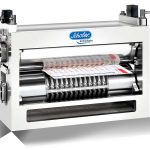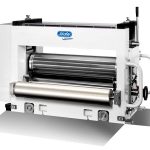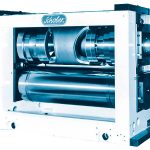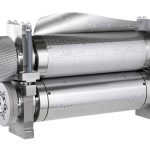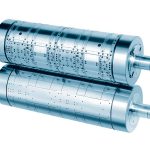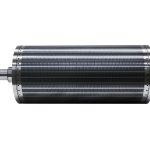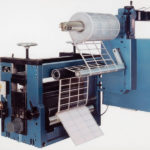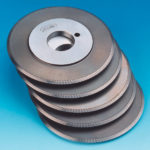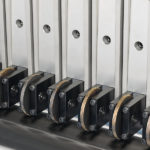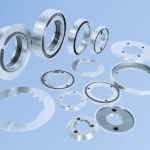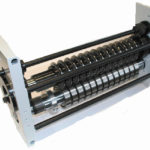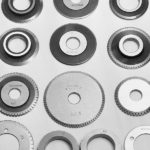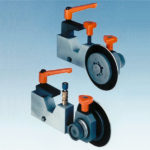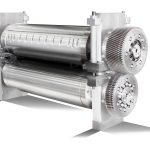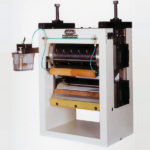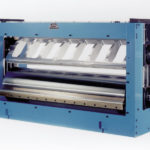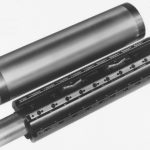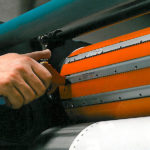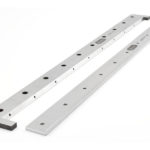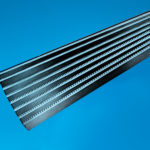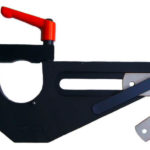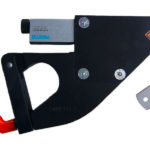Cutting & Perforating
Schober develops, manufactures and supplies a wide range of tools, modules or complete processing lines for the manufacturing of longitudinal, cross, contour and half cuts as well as perforations by proven technologies, e.g.
– Mechanical die cutting with custom designed cylinders in various material combinations
especially adapted for your needs and for production speeds up to 500 m/min (1500 ft/min).
– Edge cutting with pattern-independent welding horn paired with a custom anvil.
– Wear-resistant laser cutting and perforating with computerized High-Performance-Scanner-Optic
The different die cutting methods are used for the manufacturing of aseptic packaging, blisters, carriers, cigarette packaging, general folding cartons, coffee pads, in-mould and selfadhesive labels, liquid cartons, tea pads, hanker chief packaging, trays, panty shields, baby diapers, incontinence products, fuel cells, batteries, test stripes, solar panels, …
Contour cut
Rotary cutting technologies are employed for the form cutting of materials, laminates, non-wovens and films as thin as 10μm. Using state of the art CNC-technique almost any imaginable cutting contour can be achieved. Small quantities are mostly die cut with monobloc cutting cylinders, made of tool steel or by the use of magnetic cylinders/flexible dies. Larger quantities are preferably die cut with segmented tools. High alloy steel, powder metallurgical steels or tungsten carbide are primarily used as cutting segment materials. Die cutting segments can be exchanged easily when damaged. All die cutting materials serve as well as counter cutting materials. In addition coatings can be chosen to protect against corrosion, wear and sticky materials.
These cutting cylinders can be mounted into existing frames or into high precise modules made by Schober. Schober modules offer features for setting and controlling the die cutting/converting gap by microns. Exact product separation, wear compensation and maximum life time of the die cutting tool go without saying.
Half cut
Half cuts (mainly used for opening features or to die cut self-adhesive materials) are used to perforate or die cut to some extent the thickness of the processed material. Some of the materials are very thin, others made of several layers partly containing barrier functions. For this reason half cuts or half perforations need to be controlled exactly. Schober develops, designs and manufactures high precision modules with micro gap control features. Conical running rings on the converting tools (Gap Control System) are one of the elements allowing a micrometrical adjustment of the cutting gap. Another element are electronically controlled spindles.
Length perforation
Length perforation modules are primarily integrated into slitting machines to separate materials. In some cases special perforation shapes, such as wavy perforation lines, are used to create security features. The perforation knife holders pneumatically engage or disengage the perforation wheels. An adjustment feature for the cutting gap between the anvil cylinder and the knives is integrated in the knife holder providing an individual setting for each knife. This outstanding feature provides the advantage to use new and reground perforating wheels at the same time. The perforation wheels are suitable for converting speeds up to 300 m/min. The perforation wheels are driven by the web/anvil cylinder which is mainly driven by a servo motor.
Besides the modules and the knife holders, Schober supplies length perforation wheels. Most of the standard dimensions are on stock. Special dimensions can be supplied on short notice.
Scissor cut
During the scissor cut the upper knife is pressed with a spring against the edge of the lower knife. Due to the shearing process a smooth cutting edge is created.
This knife system is mainly used to convert paper, foil, laminates and cartons in continuous forms and label printing machines, high performance slitters as well as special converting systems with high performance cutting systems.
Schober supplies the scissor cutting knives from stock. Counter knives and knife holders can be supplied on short notice. Taylor made modules for the fixation of the knife holders can be manufactured on demand.
Pressure cut
During the pressure cut the cutting knife is pressed against a counter surface (anvil cylinder). Compared to the scissor cut, the pressure cut displaces the material. The knife is mainly driven by the web passing by and the anvil cylinder.
Schober supplies knives for the installation into existing machines and/or to be fixed into knife holders made by Schober.
Cross cut/perforation
CROSS CUTTING KNIVES. Hardened and ground, made of top quality alloy steel. These knives find their application in electronically driven cross cutting machines.
Cross cutting knives can be fixed mechanically or pneumatically (quick change version). Schober supplies cutting and perforation lines, either on reel or as piece. Most of the standard dimmensions are on stock. Special dimmensions can be supplied shortly.
Blade cut
Using a razor blade is an easy way to separate thin materials such as films. They can be fixed by a magnet (quick change version) or within fixation pins. Some blade holders can be heated to seal cutting edges or to achieve higher converting speeds.
Schober supplies standard razor blade holders on short notice. Special executions are available on demand.



